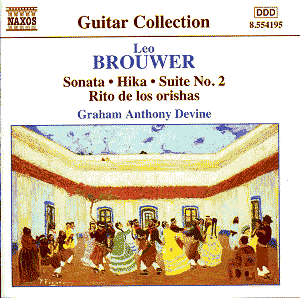There are those who approach the more contemporary
guitar repertoire with some trepidation. No need for such reservations
with this new release from the Naxos label. This is their third
volume of music for guitar by the Cuban composer Leo Brouwer.
This disc finds a friendly mix of Brouwer’s later
inventive (but still highly accessible) compositions and some
of his more lyrical works. These are all played to a remarkably
high standard by Graham Anthony Devine. His interpretations catch
exactly the right atmosphere, which is so important especially
with a composer such as Brouwer.
The more contemporary opening piece, the "Sonata",
was written for Julian Bream in 1990. Within its three movements
are incorporated themes from some of Brouwer’s many musical influences,
such as, a motif from the first (sonata form) movement of Beethoven’s
"Pastoral Symphony". This is akin to the way that Brouwer
has juxtapositioned the Fandango and the Bolero dance forms in
the first movement of his own Sonata. The second movement stimulates
an air of mystery produced from the Scriabin Piano Sonata No.9
to whom it is dedicated. The last movement quotes from Bernardo
Pasquini the 17th century harpsichordist, the piece
being "Scherzo del cucco"; the cuckoo of the title making
an appearance.
Staying on the idea of "themes", with
his "Three Latin American Pieces", Brouwer uses material
from works by two 20th century Argentinian composers,
Astor Piazzolla (1921-1992) and Carlos Guastavino (1912-2000).
He also draws on the very evocative "Danza del Altiplano"
a traditional folk tune from Peru. The Piazzolla piece in question
is "La Muerte del Angel" (The Death of the Angel). Whilst
the essence of the reworking is wholly recognisable Brouwer has
still imparted his own very distinguishable character to the original.
Although Graham Anthony Devine’s reading of "Danza del Altiplano"
is more than adequate it still does not catch the flavour as Leo
Brouwer’s own playing of this piece, of which I have three different
versions from radio broadcasts. However, this is not a criticism,
more of a personal preference.
Leo Brouwer was a great admirer of the Japanese
composer Toru Takemitsu whose death in 1996 prompted the writing
of the piece "Hika". This is a tribute to the loss of
his fellow composer and friend. Not surprisingly the work has
a feel of the orient about it and the use of the Lydian mode
abounds giving it that slight displacement of tonalities.
If "Hika" favours modal changes then
"Paisaje Cubano con campanas" (Cuban Landscape with
Carillons) is Brouwer’s vehicle for some unusual guitar effects.
Most apparent is the use of tapping, a technique more commonly
used by some of the more progressive rock guitarists where the
player taps the fingerboard of the instrument, often with both
hands. The technique is difficult but when employed correctly
can produce a quite outstanding result as Graham Anthony Devine
achieves here. The piece itself is one of a series incorporating
various viewpoints of Cuban landscape by Brouwer. Others are "Cuban
Landscape with Rain" and "Cuban Landscape with Rumba".
Brouwer’s interests in the African traditions
of Cuba are realised in the two movement "Rito de los Orishas",
a celebration of the early religious (Yoruba) rituals of the African
slave population in the casting out of evil spirits.
The remaining selection, "Suite No.2",
"An idea" and "Un dia de Noviembre" find Brouwer
in a more lyrical mood. The "Sonata No.2" is an early
work thoughtfully realised and holding themes that the composer
would use and develop in the future.
"An idea" is a beautiful tribute to
the Canadian guitar teacher Eli Kassner on the occasion of his
seventieth birthday. I am sure the recipient was highly delighted
by such a gesture, but from what I have heard of Leo Brouwer this
is fairly typical of the man. The last piece on this disc is "Un
dia de Noviembre" and shows Brouwer at his most plaintive.
This is another jewelled creation with that air of melancholy
about it that stops you in your tracks. A fine conclusion to a
fine disc with masterly playing.
Andy Daly
see also review by Paul
Shoemaker
For a biography, list of compositions and discography,
you might want to go to:
www.musicweb-international.com/brouwer/brouwer.htm
For a review of Volume 2, go to:
www.musicweb-international.com/classrev/2002/Feb02/Brouwer.htm
